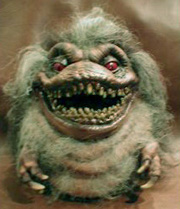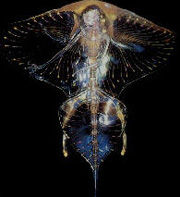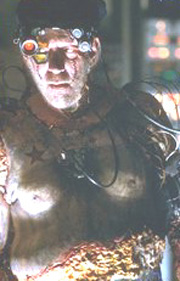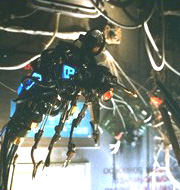Species, Part III
Krites, or Critters

Small but deadly, the Krites, or Critters, are one of the most vicious xenomorphological species studied to date. Although nothing is known of their original home world or natural life span, here at Nova Corp we have began extensive research into the Krite species for use as a biological weapon. Krite - CrittersKrite - Critters Egg laying creatures, Krite embryos incubate in their eggs for a period of six months, however the incubation period can be prolonged by reduced temperatures, causing the embryo to stay in stasis for periods of up to two years before hatching. A Krite egg is approximately 15 cm in height, being of an oval shape. Coloration of eggs can vary from brown, to brown with light green mottling, to a metallic dark green. Eggs have a hard outer shell like that of a birds, and are covered in an irregular pattern of raised interconnecting plates. A thick, sticky light green amniotic fluid fills the eggs, protecting the embryo Krites from minor collisions during early development. It is unknown as of yet whether Krites have sexes, due to the inherent problem of getting close to these deadly creatures. It may be that the Krite population consists of males and females that copulate in order to reproduce - the female laying the fertilised eggs. However, it is also possible that Krites reproduce by parthenogenesis, whereby an egg can develop without outside fertilisation, therefore allowing a single Krite to populate a new area given time.
A newly hatched Krite is small in size, roughly 15 cm in height, but will grow rapidly. Even when newly hatched, an infant Krite is capable of biting through wood, and can move quickly - easily capable of looking after itself. Baby Krites - CrittersBaby Krite - CrittersBaby Krite - CrittersBaby Krite - Critters With its fast metabolism, a Krite will quickly grow to its normal adult size once it has fed. This growth to normal size can take merely a few hours. Once "fully" grown, an adult Krite stands between 30 to 40 cm. However, it has been known for an "alpha" or "leader" to emerge within a group of Krites. This alpha will give out special pheromones, identifying it as leader and is capable of increasing its metabolism, allowing it to rapidly increase its body mass when it eats. Effectively, this means that a Krite alpha can grow to a height of around 1.70 m - about the same height as an adult human. An adult Krite appears a little like a type of reptile/mammal hybrid. Small and covered with thick, dark hair, a Krite has a distinctly reptilian face - somewhat similar to that of the prehistoric dinosaur the Velociraptor. Krite - CrittersKrite - Critters A Krite has an endoskeleton, with two legs and two arms, with three claws on each foot and hand. Its eyes are red, with a vertical slit pupil, like that of a feline. Like a feline, a Krites eyes are extremely adapt at seeing in the dark, and the light entering a Krites eyes can often reflect off its retinas, causing its eyes to appear to glow. Perhaps its most distinctive feature, a Krites mouth spans almost from one side of its head to the other, with each jaw containing three rows of small razor sharp teeth. For their size, a Krites jaws are extremely powerful, capable of biting through thick wood and ripping large chunks from their preys flesh.
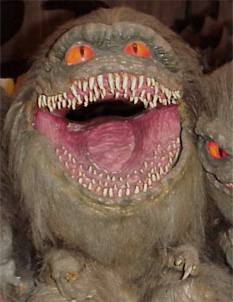
A Krites most basic function appears to be to feed and Krites are social creatures preferring to eat in groups. A Krite is a ferocious carnivore and will eat almost anything and everything. By attacking the soft neck and stomach regions of its prey, a Krite will quickly kill and devour almost any creature, large or small. As well as being able to rip through flesh with its teeth and claws, a Krite can fell large prey using quills that it can fire from its back. Arranged in a central vertical row along a Krites back, its quill are made of keratin - the same substance that fingernails are made from. Each quill contains some form of neural toxin which causes its prey to become drowsy, disorientated, and undergo a mild form of paralysis in some cases. This makes it easy for the Krite to then attack its prey which will put up very little resistance. Krite - CrittersKrite - CrittersKrite - Critters If a Krite gets in trouble it will usually quickly try to escape from its aggressor. Instead of running, a Krite will role up into a ball and will role away. However, if a Krite cannot escape from its aggressor, it will let out a cry which will alert other Krites that it needs help. This cry is very high frequency and is capable of shattering glass.
Krites can roll at relatively high velocities, and are even capable of forcing themselves to roll straight up, ascending vertically into the air, or up ventilation shafts. As well as moving as individuals, Krites possess the unusual ability to join together, gripping onto each other to form a large ball which will roll as one. These Krite balls can be made from anything from four to hundreds of Krites. Krite - Critters Although a Krite will eat almost constantly if given the chance, they are intelligent enough to occasionally save food for later if they have to go on a long trip in which food may not be readily available. In fact, although Krites are very anarchistic in nature, and in many ways quite primitive, they are also very intelligent, being capable of space travel, piloting and operating computers and keyboards. Given their intelligence it is perhaps unsurprising that the Krites have developed their own language - a collection of low, guttural sounds, throaty rasps and high pitched squeals. The Krite language, though not fully understood, has been well documented by the Karl P Anno Institute of Intergalactic Semantic Research. In conclusion, we believe that the Krite species will make an excellent, and very profitable, biological weapon, and will be making full recommendations to our military departments.
The Nocturnal Hammerhead
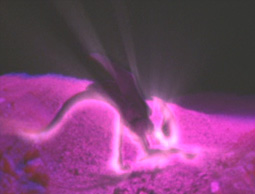
This deadly species originates on a planet with three suns, one which has almost eternal light, with only one period of darkness every 22 years. The species is, however, nocturnal, shunning light whenever possible. This is due to their very sensitive gray leathery skin which is easily damaged by light. Even a light source as weak as a flashlight will cause the skin of the nocturnal hammerhead to burn, the moisture boiling in the upper epidermis of the creature's flesh. Only able to come out once every 22 years when the planets and suns align eclipsing all three suns, this species spends the majority of their lives in the dark caverns just below the planets surface. Here they can rest, curled up clinging to the cave walls.
The basic body structure of these creatures is difficult to make out due to their preference for darkness, but it can be seen that the Nocturnal Hammerhead has a cross, or hammer, shaped head, a body ending in a split tail, a pair of wings, and two limbs which are used both as arms (balancing on its prehensile tail while gently flapping its wings) and as legs (while walking short distances). The image below, taken using light sensitive equipment, shows a Nocturnal Hammerhead using its limbs to walk. The Nocturnal Hammerhead's wings are membranous and are used in flight. Through a combination of flapping, gliding and soaring, this species can cover great distances and are able to easily bare down on prey and seize them. Nocturnal Hammerhead - Pitch Black The infants of this species are smaller versions of the adult Nocturnal Hammerheads, and are the first to emerge during the eclipse, filling the sky as they leave their underground homes in the hundreds.
Though the infants hunt in large packs, the adults of the species prefer to eat alone, saving all of the available food for themselves. They will however, sometimes co-operate in order to bring down difficult prey. During times of shortage, this species has been known to cannibalise one another. They will turn again each other, fighting tooth and claw on the ground, or will attack one another in mid air battle. Nocturnal Hammerhead - Pitch Black The Nocturnal Hammerheads are fierce carnivores. Their claws can be used to easily rip apart a man and their mouths are lined with large dagger-like sharp teeth.
As well as these common features, the Nocturnal Hammerheads also have a sharp bony crest which comprises the upper section of their heads. In conjunction with their powerful neck muscles, this crest can be used to "head butt" prey, splitting them open and killing them instantly.
Nocturnal Hammerhead - Pitch BlackNocturnal Hammerhead - Pitch Black
As well as killing and eating prey instantly, the Nocturnal Hammerheads will sometimes capture victims alive to be consumed at a later time. They can do this either by using their prehensile split tail or by using tentacles that extend from their palms to capture victims and pull them towards them.
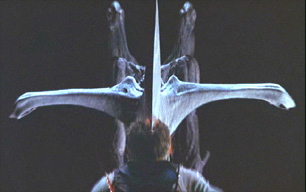 Due to their aversion to light, this species has had to develop another way to sense its prey. It is currently believed that they use some form of echo location (similar to bats or dolphins). The organs responsible for this sense are forward facing, located on either of the "face" (as with most carnivores). This does however create a blind spot in the creatures vision which some prey species are able to take advantage of. Below is a computer generated image of what we believe the Nocturnal Hammerhead "sees" when facing a human using this sense.
Due to their aversion to light, this species has had to develop another way to sense its prey. It is currently believed that they use some form of echo location (similar to bats or dolphins). The organs responsible for this sense are forward facing, located on either of the "face" (as with most carnivores). This does however create a blind spot in the creatures vision which some prey species are able to take advantage of. Below is a computer generated image of what we believe the Nocturnal Hammerhead "sees" when facing a human using this sense.

